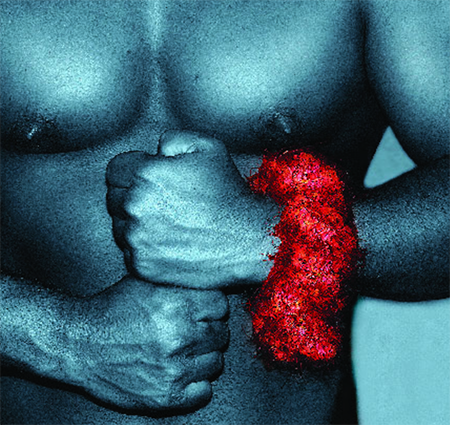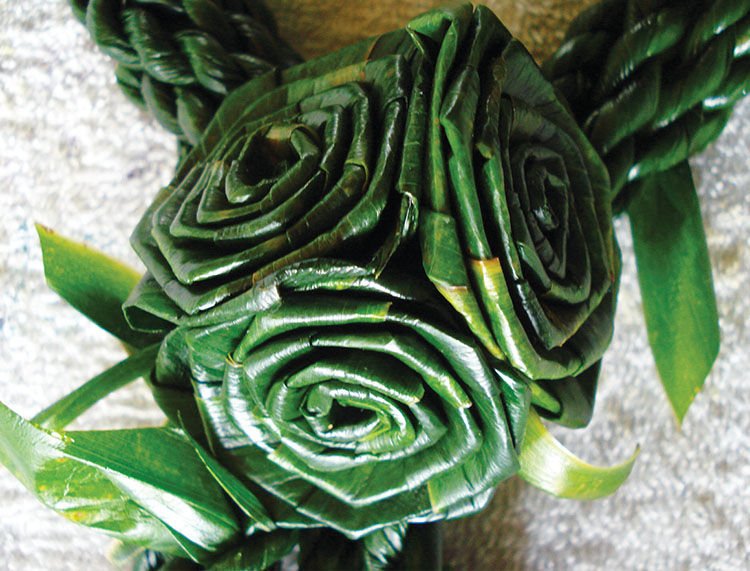
Ka Hana No‘eau i ka Hulu: “The Art of the Feather”
 By Noel Morata
By Noel Morata
Early Hawaiians believed that birds had symbolic spiritual power and their feathers carried magical properties, including keen eyesight, endurance and speed. These qualities would add to the value of garments utilizing feathers, which were created specifically for chiefly rank and status. When the early Polynesian settlers came to Hawai‘i, they brought with them the knowledge and craft of feather work. Widely recognized throughout the Pacific as masters of the craft, Hawaiians produced the most advanced feather work. Exquisite feather capes, helmets, feather lei and other garments were used primarily by the ali’i (the chiefs and nobility) of ancient times. The ahu’ula—Hawaiian feather capes—became a sacred symbol of power to the ali’i. Large feathers were also used for royal standards or kāhili, a tall, feather-topped staff used by the ali’i to symbolize status, royalty and lineage.
A great majority of the feathers were collected from endemic birds such as the Hawaiian honeycreepers found throughout the Islands. Collecting feathers was left to experienced feather gatherers called po’e hahai manu. The process of collecting was quite elaborate and time-consuming—it could last decades and even generations. These collectors spent long months in forest habitats, catching their elusive prey with fiber nets and nooses. Breadfruit tree sap was glued to various tree limbs that the most desirable birds were known to frequent.
Only a few treasured feathers could be gathered from the wings, neck and tail of the gold yellow mamo bird and the pale yellow ‘ō’ō bird. The ‘i’iwi and ‘apapane honeycreepers were sought for their red feathers, and because they were more plentiful at the time, they were usually killed and eaten.
All these prized birds, once abundant in Hawai‘i, are now more uncommon. While the scarlet ‘apapane is not endangered, it is a protected species with only 3,000 left in secluded areas of Hawai’i. The crimson-colored ‘i’iwi is considered a vulnerable species. Both the ō’ō and mamo are now extinct.
Creating the garments and other adornments required thousands of feathers. One cape alone used more than 60,000 feathers. An intricate mesh backing was made and the feathers adhered to this mesh with natural olona fibers. Striking designs of geometric patterns were created utilizing mostly the yellow and red feathers, which were symbolic of nobility and royalty. The designs were carefully considered and chosen to convey symbols of the garment wearer’s lineage or clan, as well as his ‘aumakua or spiritual connections to the universe.
Today, artisans are continuing to practice Hawaiian-style feather craft. Goose feathers are dyed to resemble the colors of the original native birds, and gathering feathers is easily accomplished by purchasing them at a variety of online sites that specialize in selling feathers from every type of bird imaginable. The common goose feather can be dyed into the popular red and yellow colors symbolic of Hawaiian ali’i. Turkey and pheasant feathers are also utilized for natural colored and patterned feathers.
One of the most respected experts of feather work on Hawai‘i island is Aunty Doreen Henderson, who founded the Lei Hulu Halau of Hilo (lei school). This halau has a genealogy that includes Aunty Mary Lou Kekuewa and Paulette Kahalepuna, better known as the “Feather Ladies of Kapahulu,” the main proponents of perpetuating this art in Hawai‘i. “I have taught at the community center for over five years and in other places for over 30 years, and I want to share this knowledge with everyone that is interested in learning,” says Aunty Doreen. She currently offers free classes to seniors over 55 at the Kea’au Community Center every Wednesday morning, and they are filled with many new students and graduates of her credentialed program. Her full curriculum entails making over 13 traditional lei and adornments, which can take an average of two years or more to complete. The center is busy and full of friendly faces sharing their aloha and enjoying time together while creating beautiful pieces of feather work. Many from Aunty Doreen’s halau participate in community outreach demonstrations for the cruise ships, Imiloa Center, Lei Day at the Lyman Museum and various senior group programs.
Laura Marable, one of Aunty Doreen’s students, has taken on the craft as a way of making a supplementary income. She also teaches to perpetuate this craft and sells her work at various local shows including the Merrie Monarch festival and teaches an introductory two-day class in the Puna district.
“I took an intensive, credentialed class in feather working through Aunty Doreen,” says Laura. “Since she gave a more traditional approach to learning feather craft, all her classes focused on traditional costuming and approaches to the craft. In my class, since they are shorter projects, I let my students decide if they would like to make the lei kamoe, the lei poepoe, or for the more adventurous students, the hat band or humu papa.” The lei wili poepoe is made with the feathers standing up for a more fluffy effect, and the lei kamoe is made with the feathers laid flat on top of each other, creating a smooth,
velvety texture.
The best part of learning a new craft like feather work is that you pick up a lot of knowledge and history about the early Hawaiians, their culture and lifestyle. Although ancient Hawaiians reserved the use of feathers for their ali’i, today feather work is available to the general public. Once utilized to show rank, lineage and status, they are used in modern times primarily for decorative purposes and creating a unique identity for each wearer.
“Feathers have recently become very popular and are turning into one of the hottest fashions trends of the year,” says Laura. Today you can see trendy feather details in hair extensions, fashionable feather earrings, necklaces and other accessories. Feathers are even being woven into clothing and shoes, creating fun and quirky details on these garments. The increase and visibility of feathers in clothing and accessories has, in turn, created more interest in Hawaiian feather work, both in learning to make the various ornaments and in finding feather art you can purchase directly from a crafter.
Contact writer Noel Morata at emorata@yahoo.com.
Resources:
Learn more about feather making and the history
of this craft by visiting www.hawaiiforvisitors.com/about/featherwork.htm
Read more in the book, Feather Lei As An Art by Auntie Mary Louise Kekuewa and Paulette Kahalepuna, published by Mutual Publishing, LLC
Take a class or the credentialed program with Aunty Doreen Henderson at the Kea’au Community Center every Wednesday morning. For more details, contact her directly at 808.982.5571.
Laura Marable’s classes in feather craft are offered regularly in the Puna area. Contact her at bigislandfeathers@gmail.com.
For feathers: www.hawaiianfeathers.com


